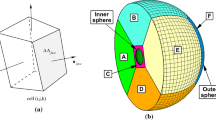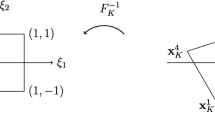Abstract
A high-order finite-volume scheme with anisotropic adaptive mesh refinement (AMR) is combined with a parallel inexact Newton method for the solution of steady compressible fluid flows governed by the Euler and Navier–Stokes equations on three-dimensional multi-block body-fitted hexahedral meshes. The proposed steady flow solution method combines a family of robust and accurate high-order central essentially non-oscillatory (CENO) spatial discretization schemes with both a scalable and efficient Newton–Krylov–Schwarz (NKS) algorithm and a block-based anisotropic AMR method. The CENO scheme is based on a hybrid solution reconstruction procedure that provides high-order accuracy in smooth regions (even for smooth extrema) and non-oscillatory transitions at discontinuities and makes use of a high-order representation of the mesh and a high-order treatment of boundary conditions. In the proposed Newton method, the resulting linear systems of equations are solved using the generalized minimal residual (GMRES) algorithm preconditioned by a domain-based additive Schwarz technique. The latter uses the domain decomposition provided by the block-based AMR scheme leading to a fully parallel implicit approach with an efficient scalability of the overall scheme. The anisotropic AMR method is based on a binary tree data structure and permits local anisotropic refinement of the grid in preferred directions as directed by appropriately specified physics-based refinement criteria. Numerical results are presented for a range of inviscid and viscous steady problems and the computational performance of the combined scheme is demonstrated and assessed.























Similar content being viewed by others
Data Availability
The datasets generated during and/or analysed during the current study are available from the corresponding author on reasonable request.
References
Groth, C.P.T., De Zeeuw, D.L., Gombosi, T.I., Powell, K.G.: Global three-dimensional MHD simulation of a space weather event: CME formation, interplanetary propagation, and interaction with the magnetosphere. J. Geophys. Res. 105(A11), 25053–25078 (2000)
De Zeeuw, D.L., Gombosi, T.I., Groth, C.P.T., Powell, K.G., Stout, Q.F.: An adaptive MHD method for global space weather simulations. IEEE Trans. Plasma Sci. 28(6), 1956–1965 (2000)
Sachdev, J.S., Groth, C.P.T., Gottlieb, J.J.: A parallel solution-adaptive scheme for predicting multi-phase core flows in solid propellant rocket motors. Int. J. Comput. Fluid Dyn. 19(2), 159–177 (2005)
Northrup, S.A., Groth, C.P.T.: Solution of laminar diffusion flames using a parallel adaptive mesh refinement algorithm. Paper 2005-0547, AIAA, January 2005
Gao, X., Groth, C.P.T.: A parallel adaptive mesh refinement algorithm for predicting turbulent non-premixed combusting flows. Int. J. Comput. Fluid Dyn. 20(5), 349–357 (2006)
Gao, X., Groth, C.P.T.: A parallel solution-adaptive method for three-dimensional turbulent non-premixed combusting flows. J. Comput. Phys. 229(5), 3250–3275 (2010)
Gao, X., Northrup, S.A., Groth, C.P.T.: Parallel solution-adaptive method for two-dimensional non-premixed combusting flows. Prog. Comput. Fluid Dyn. 11(2), 76–95 (2011)
McDonald, J.G., Sachdev, J.S., Groth, C.P.T.: Application of Gaussian moment closure to micro-scale flows with moving and embedded boundaries. AIAA J. 51(9), 1839–1857 (2014)
Freret, L., Groth, C.P.T.: Anisotropic non-uniform block-based adaptive mesh refinement for three-dimensional inviscid and viscous flows. Paper 2015-2613, AIAA, June 2015
Freret, L., Williamschen, M., Groth, C.P.T.: Enhanced anisotropic block-based adaptive mesh refinement for three-dimensional inviscid and viscous compressible flows. J. Comput. Phys. 458, 111092 (2022)
Freret, L., Ivan, L., De Sterck, H., Groth, C.P.T.: A high-order finite-volume method with anisotropic AMR for ideal MHD flows. Paper 2017-0845, AIAA, January 2017
Freret, L., Ivan, L., De Sterck, H., Groth, C.P.T.: High-order finite-volume method with block-based AMR for magnetohydrodynamics flows. J. Sci. Comput. 79(1), 176–208 (2019)
Ivan, L., Groth, C.P.T.: High-order solution-adaptive central essentially non-oscillatory (CENO) method for viscous flows. J. Comput. Phys. 257, 830–862 (2014)
Ivan, L., De Sterck, H., Susanto, A., Groth, C.P.T.: High-order central ENO finite-volume scheme for hyperbolic conservation laws on three-dimensional cubed-sphere grids. J. Comput. Phys. 282, 157–182 (2015)
Harten, A., Enquist, B., Osher, S., Chakravarthy, S.R.: Uniformly high order accurate essentially non-oscillatory schemes, III. J. Comput. Phys. 71, 231–303 (1987)
Jiang, G.-S., Shu, C.-W.: Efficient implementation of weighted ENO schemes. J. Comput. Phys. 126, 202–228 (1996)
Charest, M.R.J., Groth, C.P.T., Gauthier, P.Q.: A high-order central ENO finite-volume scheme for three-dimensional low-speed viscous flows on unstructured mesh. Commun. Comput. Phys. 17(3), 615–656 (2015)
Charest, M.R.J., Groth, C.P.T.: A high-order central ENO finite-volume scheme for three-dimensional turbulent reactive flows on unstructured mesh. Paper 2013-2567, AIAA, June 2013
Susanto, A., Ivan, L., Sterck, H.D., Groth, C.P.T.: High-order central ENO finite-volume scheme for ideal MHD. J. Comput. Phys. 250, 141–164 (2013)
Ivan, L., De Sterck, H., Northrup, S.A., Groth, C.P.T.: Hyperbolic conservation laws on three-dimensional cubed-sphere grids: a parallel solution-adaptive simulation framework. J. Comput. Phys. 255, 205–227 (2013)
Nguyen, T.B., De Sterck, H., Freret, L., Groth, C.P.T.: High-order implicit time-stepping with high-order CENO methods for unsteady three-dimensional CFD simulations. Int. J. Numer. Methods Fluids 94, 121–151 (2022)
Fu, L., Hu, X.Y., Adams, N.A.: Targeted ENO schemes with tailored resolution property for hyperbolic conservation laws. J. Comput. Phys. 349, 97–121 (2017)
Fu, L.: A very-high-order TENO scheme for all-speed gas dynamics and turbulence. Comput. Phys. Commun. 244, 117–131 (2019)
Boscheri, W., Semplice, M., Dumbser, M.: Central WENO subcell finite volume limiters for ADER discontinuous Galerkin schemes on fixed and moving unstructured meshes. Commun. Comput. Phys. 25(2), 311–346 (2019)
Tsoutsanis, P., Dumbser, M.: Arbitrary high order central non-oscillatory schemes on mixed-element unstructured meshes. Comput. Fluids 225, 2021 (2021)
Tsoutsanis, P., Adebayo, E.M., Carriba Merino, A., Perez Arjona, A., Skote, M.: CWENO finite-volume interface capturing schemes for multicomponent flows using unstructured meshes. J. Sci. Comput. 89, 2021 (2021)
Pueyo, A., Zingg, D.W.: An efficient Newton-GMRES solver for aerodynamic computations. Paper 97-1955, AIAA, June 1997
Groth, C.P.T., Northrup, S.A.: Parallel implicit adaptive mesh refinement scheme for body-fitted multi-block mesh. Paper 2005-5333, AIAA, June 2005
Nejat, A., Ollivier-Gooch, C.: Effect of discretization order on preconditioning and convergence of a high-order unstructured finite-volume Newton-Krylov solver for inviscid compressible flows. Paper 2007-719, AIAA, January 2007
Wong, P., Zingg, D.W.: Three-dimensional aerodynamic computations on unstructured grids using a Newton–Krylov approach. Comput. Fluids 37(2), 107–120 (2008)
Hicken, J.E., Zingg, D.W.: Parallel Newton–Krylov solver for the Euler equations discretized using simultaneous approximation terms. AIAA J. 46(11), 2773–2786 (2008)
Nejat, A., Ollivier-Gooch, C.: A high-order accurate unstructured finite-volume Newton–Krylov algorithm for inviscid compressible flows. J. Comput. Phys. 227, 2582–2609 (2008)
Dias, S.C., Zingg, D.W.: A high-order parallel Newton–Krylov flow solver for the Euler equations. Paper 2009-3657, AIAA, June 2009
Northrup, S.A., Groth, C.P.T.: Parallel implicit adaptive mesh refinement scheme for unsteady fully-compressible reactive flows. Paper 2013-2433, AIAA, June 2013
Saad, Y., Schultz, M.H.: GMRES: a generalized minimal residual algorithm for solving nonsymmetric linear equations. SIAM J. Sci. Stat. Comput. 7(3), 856–869 (1986)
Saad, Y.: Krylov subspace methods on supercomputers. SIAM J. Sci. Stat. Comput. 10(6), 1200–1232 (1989)
Brown, P.N., Saad, Y.: Hybrid Krylov methods for nonlinear systems of equations. SIAM J. Sci. Stat. Comput. 11(3), 450–481 (1990)
Saad, Y.: Iterative Methods for Sparse Linear Systems. PWS Publishing Company, Boston (1996)
Charest, M.R.J., Groth, C.P.T., Gülder, Ö.L.: Solution of the equation of radiative transfer using a Newton–Krylov approach and adaptive mesh refinement. J. Comput. Phys. 231, 3023–3040 (2012)
Schlichting, H., Gersten, K.: Boundary-Layer Theory, 8th edn. Springer, New York (2000)
Hirsch, C.: Numerical Computation of Internal and External Flows, Volume 1, Fundamentals of Numerical Discretization. Wiley, Toronto (1989)
Harten, A., Lax, P.D., van Leer, B.: On upstream differencing and Godunov-type schemes for hyperbolic conservation laws. SIAM Rev. 25(1), 35–61 (1983)
Einfeldt, B.: On Godunov-type methods for gas dynamics. SIAM J. Numer. Anal. 25, 294–318 (1988)
Gottlieb, J.J., Groth, C.P.T.: Assessment of Riemann solvers for unsteady one-dimensional inviscid flows of perfect gases. J. Comput. Phys. 78, 437–458 (1988)
Toro, E.F.: Riemann Solvers and Numerical Methods for Fluid Dynamics: A Practical Introduction. Springer, New York (1999)
Petrov, M.N., Tambova, A.A., Titarev, V., Utyuzhnikov, S., Chikitkin, A.: FlowModellium software package for calculating high-speed flows of compressible fluid. Comput. Math. Math. Phys. 58(11), 1865–1886 (2018)
Barth, T.J.: Recent developments in high order k-exact reconstruction on unstructured meshes.’ Paper 93-0668, AIAA, January 1993
Venkatakrishnan, V.: On the accuracy of limiters and convergence to steady state solutions. Paper 93-0880, AIAA, January 1993
Tsoutsanis, P.: Stencil selection algorithms for WENO schemes on unstructured meshes. J. Comput. Phys. X 4, 2019 (2019)
Zienkiewicz, O.C., Taylor, R.L., Zhu, Z.Z.: The Finite Element Method: Its Basis and Fundamentals, 7th edn. Elsevier, New York (2013)
Jalali, A.: An Adaptive Higher-Order Unstructured Finite Volume Solver for Turbulent Compressible Flows. PhD thesis, University of British Columbia (2017)
Costa, R., Nobrega, J.M., Clain, S., Machado, G.: Very high-order accurate polygonal mesh finite volume scheme for conjugate heat transfer problems with curved interfaces and imperfect contacts. Comput. Methods Appl. Mech. Eng. 117(2), 112560 (2019)
Lapidus, L., Pinder, G.F.: Numerical Solution of Partial Differential Equations in Science and Engineering. Wiley, Toronto (1999)
Anderson, D.A., Tannehill, J.C., Pletcher, R.H.: Computational Fluid Mechanics and Heat Transfer. McGraw-Hill, Toronto (1984)
Thompson, J.F., Warsi, Z.U.A., Mastin, C.W.: Numerical Grid Generation-Foundations and Applications. North-Holland, New York (1985)
Ollivier-Gooch, C.F., Altena, M.V.: A high-order accurate unstructured mesh finite-volume scheme for the advection–diffusion equation. J. Comput. Phys. 181(2), 729–752 (2002)
Dembo, R.S., Eisenstat, S.C., Steihaug, T.: Inexact newton methods. SIAM J. Numer. Anal. 19(2), 400–408 (1982)
Mulder, W.A., van Leer, B.: Experiments with implicit upwind methods for the Euler equations. J. Comput. Phys. 59, 232–246 (1985)
Ronchi, C., Iacono, R., Paolucci, P.S.: The “Cubed Sphere": A new method for the solution of partial differential equations in spherical geometry. J. Comput. Phys. 124, 93–114 (1996)
Hoshyari, S.: A high-order unstructured finite volume solver for three-dimensional compressible flows. Master’s thesis, University of British Columbia (2017)
Henderson, R.D.: Details of the drag curve near the onset of vortex shedding. Phys. Fluids 7(9), 2102–2104 (1995)
Kannan, R., Wang, Z.J.: A study of viscous flux formulations for a p-multigrid spectral volume Navier Stokes solver. J. Sci. Comput. 41(2), 165–199 (2009)
Acknowledgements
This work was supported by the Canadian Space Agency and by the Natural Sciences and Engineering Research Council (NSERC) of Canada. In particular, the authors would like to acknowledge the financial support received from the Canadian Space Agency through the Geospace Observatory Canada program under grant number 14SUGOAMSM. Computational resources for performing all of the calculations reported herein were provided by the SciNet High Performance Computing Consortium at the University of Toronto and Compute/Calcul Canada through funding from the Canada Foundation for Innovation (CFI) and the Province of Ontario, Canada.
Author information
Authors and Affiliations
Corresponding author
Additional information
Publisher's Note
Springer Nature remains neutral with regard to jurisdictional claims in published maps and institutional affiliations.
Appendix A. Appendix
Appendix A. Appendix
1.1 A.1 Trilinear Transformation
The trilinear transformation is defined by

where p, q and r are the Cartesian coordinates in the canonical space of the reference cube. The transformation vector coefficients for the trilinear transformation are defined by \({\mathbf{T_1}}\), \({\mathbf{T_2}}\), \({\mathbf{T_3}}\), \({\mathbf{T_4}}\), \({\mathbf{T_5}}\), \({\mathbf{T_6}}\), \({\mathbf{T_7}}\) and \({\mathbf{T_8}}\) which are in turn given by
where \({\mathbf{N_1}}\), \({\mathbf{N_2}}\), \({\mathbf{N_3}}\), \({\mathbf{N_4}}\), \({\mathbf{N_5}}\), \({\mathbf{N_6}}\), \({\mathbf{N_7}}\) and \({\mathbf{N_8}}\) are the vertices of the hexahedron as depicted in Fig. 24a. The tangent vectors to the coordinate lines are defined by

1.2 A.2 Tricubic Transformation
The tricubic transformation is defined by

and the corresponding tangent vectors to the coordinate lines are defined by

The transformation vector coefficients is this case are given by



Here \({\mathbf{N_1}}\)–\({\mathbf{N_8}}\) are the vertices of the hexahedron and \({\mathbf{N_9}}\)–\({\mathbf{N_32}}\) are the high-order nodes as depicted in Fig. 24b.
1.3 A.3 Transformation Jacobians
The determinants of the Jacobians for volume and surface integration are given by

Rights and permissions
Springer Nature or its licensor (e.g. a society or other partner) holds exclusive rights to this article under a publishing agreement with the author(s) or other rightsholder(s); author self-archiving of the accepted manuscript version of this article is solely governed by the terms of such publishing agreement and applicable law.
About this article
Cite this article
Freret, L., Ngigi, C.N., Nguyen, T.B. et al. High-Order CENO Finite-Volume Scheme with Anisotropic Adaptive Mesh Refinement: Efficient Inexact Newton Method for Steady Three-Dimensional Flows. J Sci Comput 94, 48 (2023). https://doi.org/10.1007/s10915-022-02068-3
Received:
Revised:
Accepted:
Published:
DOI: https://doi.org/10.1007/s10915-022-02068-3





